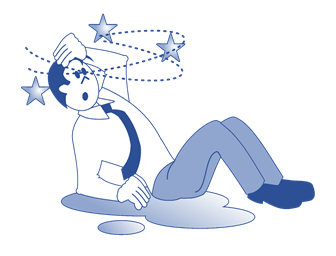Understanding the Common Causes of Slips
Slips typically occur when there is a loss of traction between a person’s footwear and the surface they are walking on. Several factors can contribute to this loss of traction, and it’s important to understand these factors to take appropriate actions to prevent accidents. The main contributors to slip accidents include:
- The floor condition: Slippery walking surfaces due to wetness, grease, or other substances can increase the risk of slipping.
- Footwear: Improper footwear or shoes with worn-out soles can lead to poor grip and an increased likelihood of slipping.
- Speed and force of movement: Running or moving too quickly can reduce the time a person has to react to unexpected hazards.
- Environmental factors: Poor lighting or visibility can make it harder for employees to spot wet or slippery areas.
The floor in a workplace must be suitable for the type of work activity taking place on it. The Workplace (Health, Safety, and Welfare) Regulations (Reg 12) require that floors be suitable, in good condition, and free from obstructions to allow people to move around safely.
To prevent slips, employers should regularly check the floors to ensure that they are clean and dry and provide employees with advice about proper footwear. In addition, addressing environmental factors such as lighting can help employees better spot hazards, avoid slipping, and prevent fall incidents.
Are there specific industries or workplaces that are more prone to slips, trips, and falls?
Certain industries like construction, healthcare, and hospitality are more prone to slips, trips, and falls due to the nature of the work and the environment. However, any workplace can be at risk if proper safety measures and precautions are not in place to prevent accidents.
Preventing Trips in the Workplace
While slips often occur on smooth or wet surfaces, trips are usually caused by obstructions or uneven surfaces in walkways. The majority of trip accidents occur when employees accidentally stumble over items in their path or encounter uneven flooring. Preventing trip-related accidents is often straightforward and can be achieved through regular checks and effective maintenance.
Walkways
The first step in preventing trips is to ensure that walkways are clear and unobstructed. Employers should regularly inspect common walkways and paths to ensure they are appropriately located, clearly marked, and free from obstacles. Additionally, employers should consider whether any tasks or equipment are obstructing pathways or making it difficult for employees to see where they are walking.
Housekeeping
Good housekeeping practices are essential in maintaining safe walkways. It’s not enough to simply provide a clear path; those walkways must be kept clear throughout the workday. This includes removing trailing wires, tools, boxes, and other objects that may cause employees to trip. Implementing a “see it, sort it” attitude among employees and cleaners can help ensure that work areas remain free of clutter and obstructions. It's also essential to maintain an effective cleaning regime and ensure that there are enough storage and waste disposal facilities to keep the workplace tidy.
Design and Maintenance to Prevent Slips, Trips and Falls at Work
Proper design and ongoing maintenance of walkways are also critical to preventing trips. Walkways should be wide enough to accommodate the movement of workers and equipment, and they should be level and free from cracks or gaps. Stairs should be designed with consistent risers, non-slip nosings, and sturdy handrails. Regular maintenance should include checking for any wear and tear that could create trip hazards. Environmental factors such as lighting also play a role—poor lighting can make it difficult for workers to see hazards like uneven surfaces or obstacles.
The Health and Safety Executive has produced guidance for architects and designers to provide practical advice on how to pick new flooring or modify existing floors and stairs to prevent slipping.
Taking a Comprehensive Approach
To effectively prevent slips, trips, and falls, employers must focus on all aspects of the workplace environment, from the condition of floors and walkways to the behaviour and awareness of employees. A comprehensive approach includes:
- Regular inspections of work areas, walkways, and equipment.
- Employee training on recognising and addressing hazards.
- Clear housekeeping protocols to maintain tidy workspaces.
- Ensuring proper floor design and maintenance to eliminate trip hazards.
- Improving lighting to enhance visibility and help employees avoid hazards.
By taking these proactive steps, employers can significantly reduce the risk of falling, leading to a safer, more productive work environment for everyone.
For employee training, try the Commodious Online Slips, Trips, and Falls Training Course.



